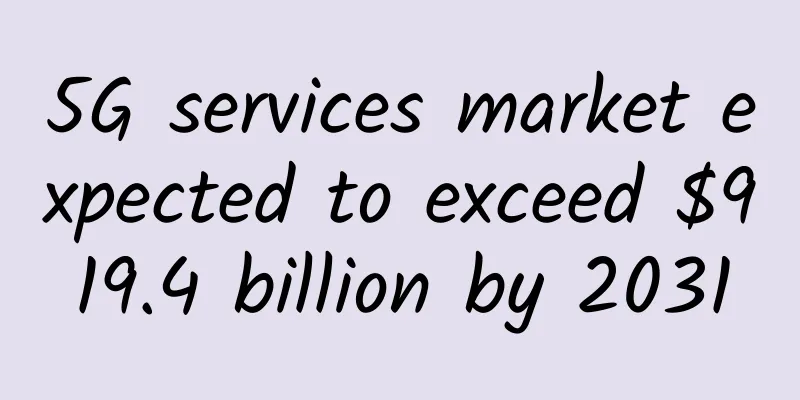5G services market expected to exceed $919.4 billion by 2031

|
According to a recent report by Transparency Market Research, the global 5G services market is expected to exceed $919.4 billion by 2031. This equates to a compound annual growth rate (CAGR) of 30.8%, with the market expected to be worth $82.7 billion in 2022. As 5G technology gains traction, it is ushering in major changes in the digital landscape. 5G technology represents an unprecedented shift in wireless communications. Unlike its predecessors, 5G features multi-gigabit data rates, peak speeds of up to 20 Gbps, and ultra-low latency of less than 5 milliseconds. This opens up a world of possibilities, especially in industries where real-time data processing is critical. The adoption of 5G services is not limited to mobile phone manufacturers. It has expanded exponentially to improve wireless communication infrastructure. The demand for 5G services is growing to meet the needs of projects such as smart cities, smart buildings, and advanced industrial applications. In addition, the rise of cloud-based applications has prompted governments around the world to invest in strengthening 5G deployment. While the COVID-19 pandemic has presented unprecedented challenges, it has highlighted the importance of 5G technology. Organizations across industries have leveraged 5G capabilities to enable remote work, thereby ensuring business continuity in times of adversity. As a result, the pandemic has accelerated investment in 5G technology, with industries relying on it to enable remote operations, safety measures, and support for emerging technologies such as IoT, AR/VR, and autonomous systems. Among the various market segments impacted by 5G services, managed services have emerged as a dominant force due to their primary focus on cost reduction and operational efficiency. Technologies such as GSM (Global System for Mobile Communications) have seen significant growth due to their wide coverage and strong security features. Similarly, enhanced mobile broadband (eMBB) has captured a large market share due to its wide range of uses in residential and commercial sectors. The commercial sector accounted for the major share of market revenue, driven by the need for increased broadband speeds and seamless connectivity. Industries such as IT & telecommunications, manufacturing, and media & entertainment are leading the adoption of 5G services. The dominance of the commercial sector is amplified by the rise of virtual meetings and the increasing demand for high-speed data transmission. Geographically, Asia Pacific dominates the global 5G services market. Rapid technological advancement coupled with a growing population has created fertile soil for the adoption of 5G as countries such as South Korea, Japan, and China are paving the way. The demand for cloud-based solutions and emerging technologies has further strengthened the adoption of 5G technology in the region. As we move toward a future defined by digital connectivity, 5G services will grow exponentially. Key industry players are actively shaping this landscape, focusing on innovation, strategic partnerships, and technological advancements. From enabling enterprise private 5G network deployments to revolutionizing consumer experiences, the potential of 5G technology appears limitless. The transformative power of 5G technology serves as a beacon of progress in the digital age, unlocking new possibilities and reshaping industries. With leading and innovative solutions emerging in Asia Pacific, the future of 5G services appears brighter than ever. |
<<: Why are there so many different communication protocols in industrial sites?
>>: Ruijie Networks Tailors the Campus Network for Guizhou University of Finance and Economics
Recommend
Talk: Application is slowed down? The culprit is Log4j!
[[338229]] Some time ago, we discovered that a Sa...
5G will make your 4G mobile phone obsolete. How can you become a "pig" in the 5G trend?
[[223756]] According to Gartner data, the total s...
5G network construction 80%: 5G robots are about to usher in a new turning point
Recently, according to CCTV News, China had compl...
Popular understanding of the seven-layer network protocol
[[256704]] The seven layers of OSI are briefly in...
20 industries that 5G technology can change
5G is changing the way we connect. The technology...
DMIT: Hong Kong CN2 GIA/US CN2 GIA line large bandwidth VPS quarterly payment starting from US$28.8
DMIT.io is a foreign hosting company established ...
Migrating manufacturing to Industry 5.0 with 5G
Chicago’s Digital Manufacturing Institute and the...
To help students' future, Ruijie Smart Cloud Classroom creates a new teaching model
[51CTO.com original article] Recalling the scene ...
Arasaka: San Jose high-security VPS monthly payment starting from 100 yuan, AS9929 line
Arasaka Network LLC is a newly opened overseas VP...
As 5G development enters the second half, what kind of report card has been delivered?
It has been four years since China issued 5G comm...
How to change ssh port in CentOS7.*
I checked the port modification records in the si...
Four SD-WAN misconceptions
When any technology or service is sold in large q...
UBBF2020: Intelligent connectivity, creating new growth in industry value
[Beijing, China, October 13, 2020] Today, the 6th...
Three things you need to know before embarking on the journey of becoming a data scientist
【51CTO.com Quick Translation】 Currently, the indu...
5G core network revenue expected to reach $1 billion by 2020
5G core network revenue will reach $1 billion in ...









